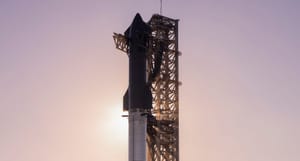
In a SpaceX 'all-hands' meeting posted to X, formerly Twitter, Elon Musk, the company's CEO and founder, announced the goals for Starship-Super Heavy's next flight!
Flight three of Starship-Super Heavy is likely going to be performed with Ship 28 and Super Heavy Booster 10 with the following goal according to Musk:
"Flight three we want to get to orbit and we want to do an in-space engine burn from the header tank and prove that we can reliably de-orbit."
The flight plan will likely be similar to the past two flights but with an additional burn planned to demonstrate a de-orbit maneuver. When Starship reaches orbit it will be the largest object to enter orbit so proving it can safely de-orbit itself is highly likely to be necessary.
So far no Starship-Super Heavy vehicle has survived flight or reached their planned flight path successfully.
Musk also provided insight into why Ship 25 was lost during Starship-Super Heavy's second flight. Ship 25 was venting liquid oxygen from its tank which caused an unexpected fire on the ship followed shortly by an explosion, which would destroy the vehicle.
Musk also added that if the ship wasn't venting liquid oxygen it would have made it to entry into Earth's atmosphere.

It was finally confirmed that a second launch tower would begin construction in Texas. SpaceX has already been spotted moving hardware over from Florida to begin construction of the second tower.
Two towers in Texas would support a faster flight cadence of Starship-Super Heavy while the vehicle is still in development.
There were also hints of more upgrades to Starship-Super Heavy to lengthen the vehicle to up to 150 meters and to increase the thrust to 20 million pounds of thrust, or 9070 tons of thrust.
Musk also provided insights into some of Falcon 9's milestones and goals for the upcoming year.
It was revealed that so far Falcon 9 fairings have been reused three-hundred times, which saves SpaceX roughly six million United States dollars per reuse.
Musk also said that the Falcon 9 boosters are looking at being flown up to forty times, an increase from the twenty that used to be planned.

The Polaris Dawn mission is also reportedly still planned for early 2024 which will see the first extravehicular activity from SpaceX's Crew Dragon spacecraft during a 'free-flight' mission. Musk also said that the spacesuit for the mission needed to be one that could allow a person to be mobile and low cost.
What is Starship-Super Heavy?
Starship-Super Heavy is SpaceX's in-development fully reusable super heavy-lift launch vehicle. SpaceX aims to have the launch vehicle deliver two hundred tons to low Earth orbit while reused or two hundred and fifty tons when expended.
Starship is the second-stage of the Starship-Super Heavy launch vehicle and is planned to be reused. The Starship second stage is fifty meters tall and nine meters wide. The second stage is powered by three sea-level Raptor engines and three vacuum Raptor Engines with plans to increase it to six in the future, these engines burn liquid methane and liquid oxygen with a maximum thrust of 1500 tons. Starship is believed to weigh one hundred tons empty and one thousand three hundred tons fully fuelled. For reusability, Starship will separate from the booster, Super Heavy, in flight and continue up toward orbit. After a few orbits Starship will perform a deorbit burn and re-enter the atmosphere, after re-entry, Starship will aim to land on the chopsticks' of the launch tower, also called Mechazilla.
Super Heavy is the first-stage booster for the Starship-Super Heavy launch vehicle and is planned to be reused, it is also currently the most powerful rocket stage ever flown. The Super Heavy booster is seventy-one meters tall and nine meters wide. The booster is powered by thirty-three Raptor engines burning liquid methane and liquid oxygen with a maximum thrust of 7590 tons. Super Heavy is believed to weigh two hundred tons empty and three thousand six hundred tons fully fuelled. For reusability, Super Heavy will launch from the Orbital Launch Mount and will then perform a boost back burn and land on the 'chopsticks' of the launch tower, also called Mechazilla, using its grid fins at the top for greater aerodynamic control during unpowered flight. Super Heavy also has a hot-staging ring atop of it to improve the performance of the Starship-Super Heavy stack and simplify the staging process.
The Starship-Super Heavy launch vehicle is currently 121 meters tall on the launch pad. The launch vehicle is believed to weigh 5,000,000 kilograms when fully fuelled before launch.



